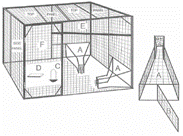Eastern Wildlife Damage Control Conferences

Eastern Wildlife Damage Management Conference: 8th (1997)
The Legal Roles and Responsibilities of a Community Concerning Crop Depredation by White-Tailed Deer
Date of this Version
October 1997
Document Type
Article
Abstract
The interwoven issues of the legal roles and responsibilities that landowners (i.e., farmers, foresters, and hunters) and a state agency have to control deer densities in rural areas that directly affect crop depredation and various stakeholders will be addressed in this paper. Because unmanaged deer populations severely can damage agricultural crops, the financial cost of this deer damage is borne entirely by individual private landowners. The South Carolina Department of Natural Resources (SCDNR) is the regulatory state agency in South Carolina responsible for annually promulgating rules and regulations pertaining to white-tailed deer harvest by hunters. Even though deer are property of the state and SCDNR is responsible for establishing legal harvest limits and open seasons, it alone cannot manage deer densities. Common crop depredation problems, responsibilities, and solutions regarding deer in South Carolina are presented, based on our investigation of legal sources such as the South Carolina Code of Laws, U.S. Constitution, State Constitution of South Carolina, and Common Law. Suggestions are presented for rural landowners who want to manage natural resources and agriculture on their property. Landowners who hunt and/or allow hunting on their property are the key to successful management of deer as a public resource. The ability to effectively manage deer is up to individual landowners. However, because private landowners have no legal responsibility to manage wild deer populations, minimizing crop depredation through legal harvest remains an ancillary benefit of rural landowners' sport hunting objectives.


Comments
Published in Proceedings of the Eighth Eastern Wildlife Damage Management Conference, Roanoke, Virginia, October 16–19, 1997, edited by James A. Parkhurst. Copyright © 1997 by the authors.